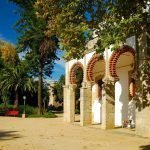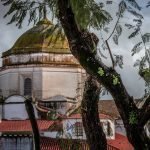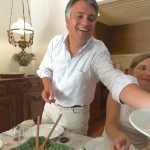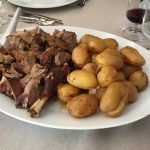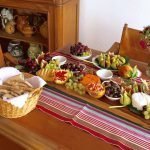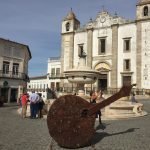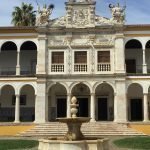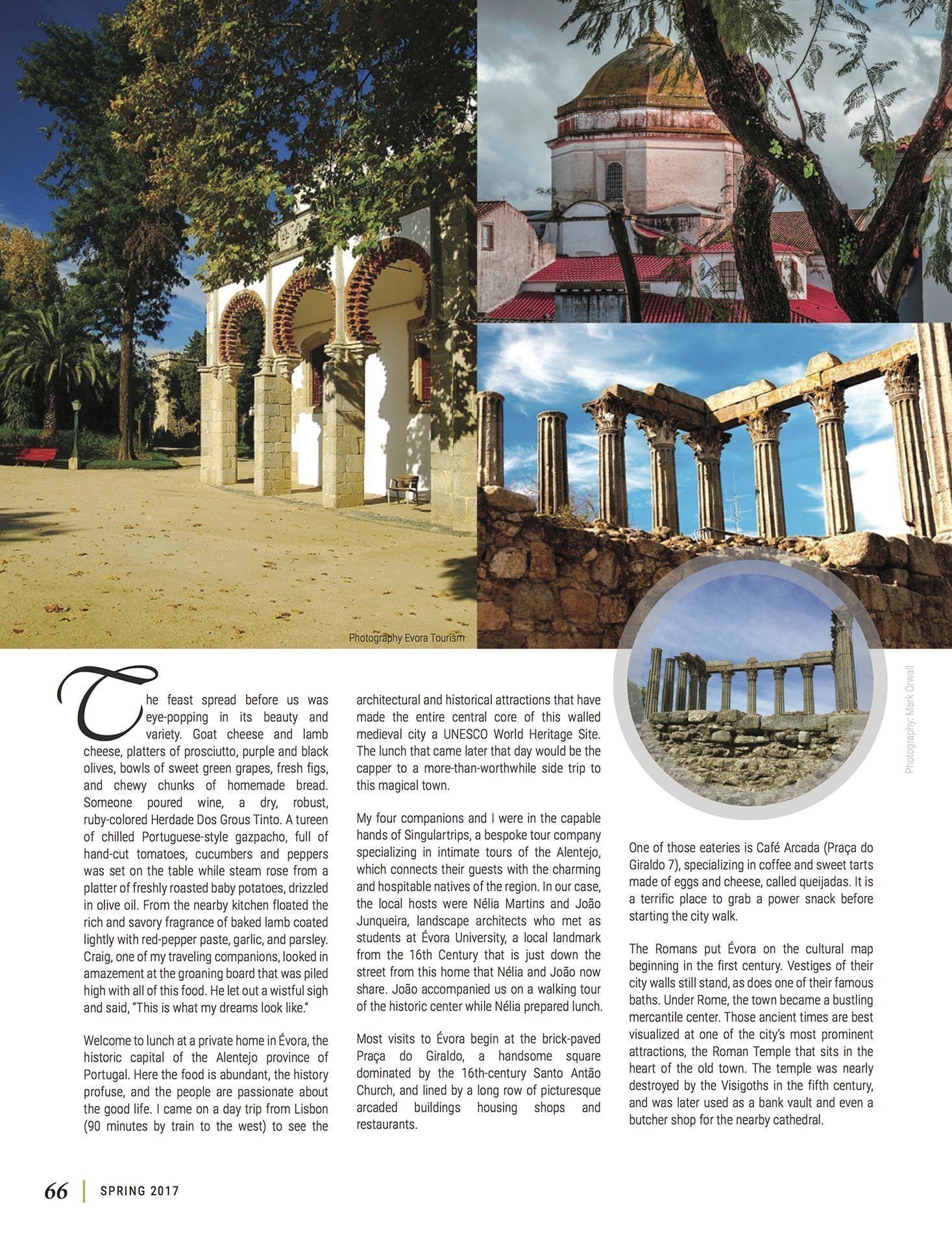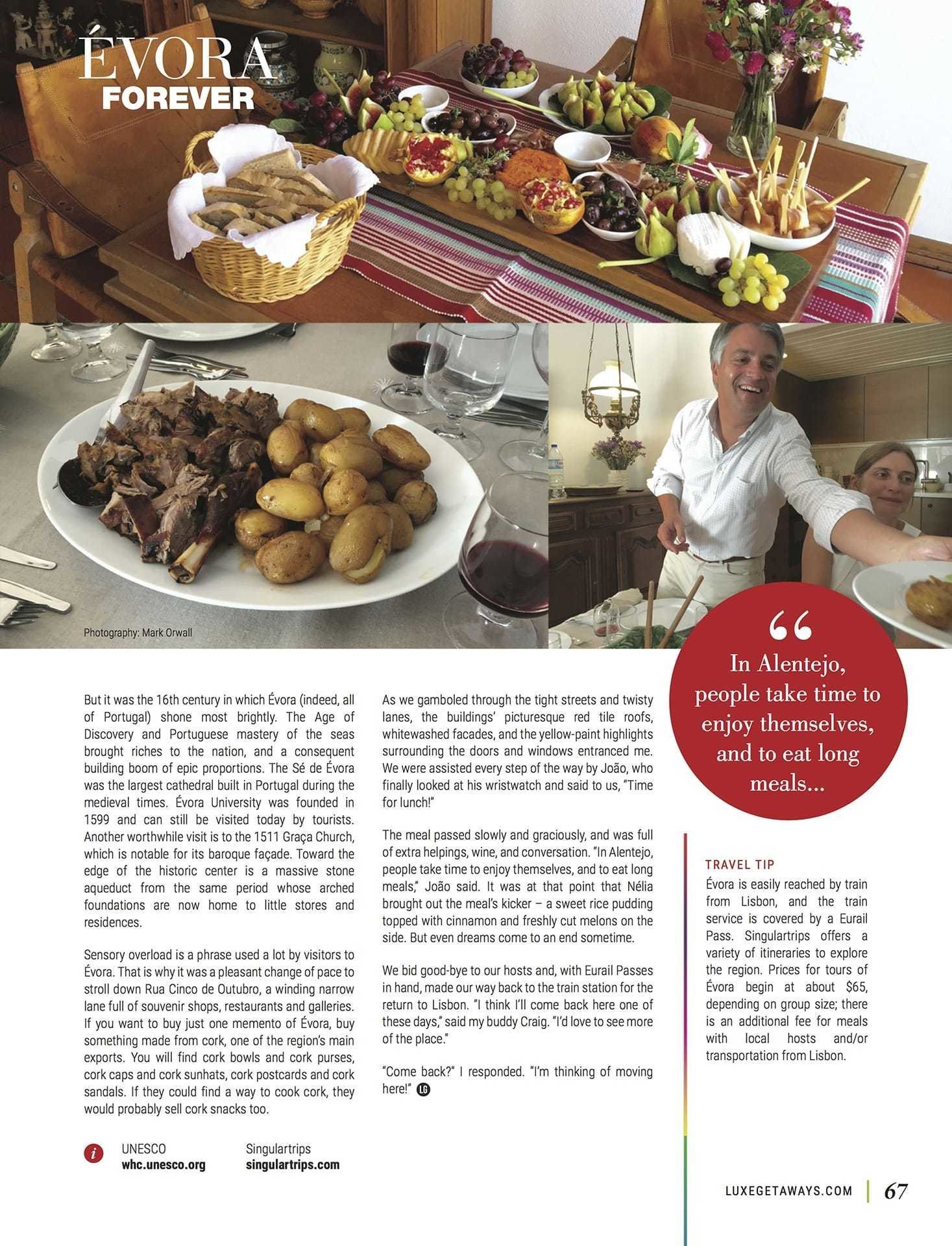LuxeGetaways Magazine – Spring 2017 | The feast spread before us was eye-popping in its beauty and variety. Goat cheese and lamb cheese, platters of prosciutto, purple and black olives, bowls of sweet green grapes, fresh figs, and chewy chunks of homemade bread. Someone poured wine, a dry, robust, ruby-colored Herdade Dos Grous Tinto. A tureen of chilled Portuguese-style gazpacho, full of hand-cut tomatoes, cucumbers and peppers was set on the table while steam rose from a platter of freshly roasted baby potatoes, drizzled in olive oil. From the nearby kitchen floated the rich and savory fragrance of baked lamb coated lightly with red-pepper paste, garlic, and parsley. Craig, one of my traveling companions, looked in amazement at the groaning board that was piled high with all of this food. He let out a wistful sigh and said, “This is what my dreams look like.”
Welcome to lunch at a private home in Évora, the historic capital of the Alentejo province of Portugal. Here the food is abundant, the history profuse, and the people are passionate about the good life. I came on a day trip from Lisbon (90 minutes by train to the west) to see the architectural and historical attractions that have made the entire central core of this walled medieval city a UNESCO World Heritage Site. The lunch that came later that day would be the capper to a more-than-worthwhile side trip to this magical town.
My four companions and I were in the capable hands of Singulartrips, a bespoke tour company specializing in intimate tours of the Alentejo, which connects their guests with the charming and hospitable natives of the region. In our case, the local hosts were Nélia Martins and João Junqueira, landscape architects who met as students at Évora University, a local landmark from the 16th Century that is just down the street from this home that Nélia and João now share. João accompanied us on a walking tour of the historic center while Nélia prepared lunch.

Most visits to Évora begin at the brick-paved Praça do Giraldo, a handsome square dominated by the 16th-century Santo Antão Church, and lined by a long row of picturesque arcaded buildings housing shops and restaurants. One of those eateries is Café Arcada (Praça do Giraldo 7), specializing in coffee and sweet tarts made of eggs and cheese, called queijadas. It is a terrific place to grab a power snack before starting the city walk.
The Romans put Évora on the cultural map beginning in the first century. Vestiges of their city walls still stand, as does one of their famous baths. Under Rome, the town became a bustling mercantile center. Those ancient times are best visualized at one of the city’s most prominent attractions, the Roman Temple that sits in the heart of the old town. The temple was nearly destroyed by the Visigoths in the fifth century, and was later used as a bank vault and even a butcher shop for the nearby cathedral.
But it was the 16th century in which Évora (indeed, all of Portugal) shone most brightly. The Age of Discovery and Portuguese mastery of the seas brought riches to the nation, and a consequent building boom of epic proportions. The Sé de Évora was the largest cathedral built in Portugal during the medieval times. Évora University was founded in 1599 and can still be visited today by tourists. Another worthwhile visit is to the 1511 Graça Church, which is notable for its baroque façade. Toward the edge of the historic center is a massive stone aqueduct from the same period whose arched foundations are now home to little stores and residences.
Sensory overload is a phrase used a lot by visitors to Évora. That is why it was a pleasant change of pace to stroll down Rua Cinco de Outubro, a winding narrow lane full of souvenir shops, restaurants and galleries. If you want to buy just one memento of Évora, buy something made from cork, one of the region’s main exports. You will find cork bowls and cork purses, cork caps and cork sunhats, cork postcards and cork sandals. If they could find a way to cook cork, they would probably sell cork snacks too.
As we gamboled through the tight streets and twisty lanes, the buildings’ red tile roofs, whitewashed facades, and the yellow-paint highlights surrounding the doors and windows entranced me. We were assisted every step of the way by João, who finally looked at his wristwatch and said to us, “Time for lunch!”
The meal passed slowly and graciously, and was full of extra helpings, wine, and conversation. “In Alentejo, people take time to enjoy themselves, and to eat long meals,” João said. It was at that point that Nélia brought out the meal’s kicker – a sweet rice pudding topped with cinnamon and freshly cut melons on the side. But even dreams come to an end sometime.
We bid good-bye to our hosts and, with Eurail Passes in hand, made our way back to the train station for the return to Lisbon. “I think I’ll come back here one of these days,” said my buddy Craig. “I’d love to see more of the place.”
“Come back?” I responded. “I’m thinking of moving here!”
Additional Details:
Évora is easily reached by train from Lisbon, and the train service is covered by a Eurail Pass. Singulartrips offers a variety of itineraries to explore the region. Prices for tours of Évora begin at about $65, depending on group size; there is an additional fee for meals with local hosts and/or transportation from Lisbon.
UNESCO
www.whc.unesco.org
Singulartrips
www.singulartrips.com
Visit LuxeGetaways.com/magazine to view the Spring 2017 Issue


